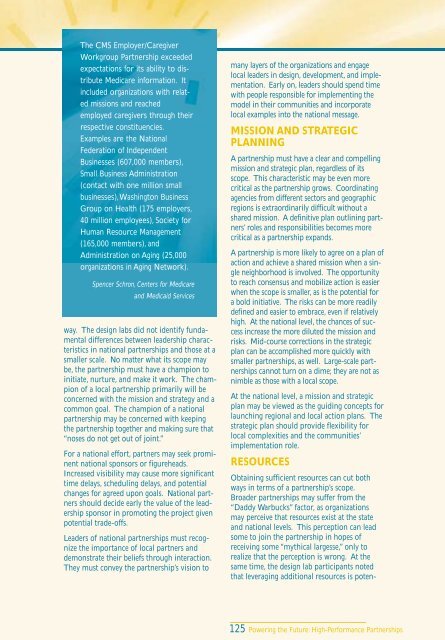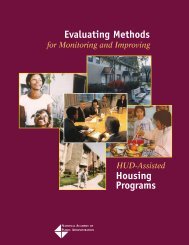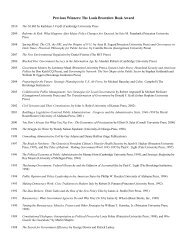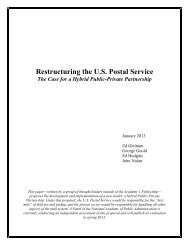High-Performance Partnerships - National Academy of Public ...
High-Performance Partnerships - National Academy of Public ...
High-Performance Partnerships - National Academy of Public ...
Create successful ePaper yourself
Turn your PDF publications into a flip-book with our unique Google optimized e-Paper software.
The CMS Employer/Caregiver<br />
Workgroup Partnership exceeded<br />
expectations for its ability to distribute<br />
Medicare information. It<br />
included organizations with related<br />
missions and reached<br />
employed caregivers through their<br />
respective constituencies.<br />
Examples are the <strong>National</strong><br />
Federation <strong>of</strong> Independent<br />
Businesses (607,000 members),<br />
Small Business Administration<br />
(contact with one million small<br />
businesses),Washington Business<br />
Group on Health (175 employers,<br />
40 million employees), Society for<br />
Human Resource Management<br />
(165,000 members), and<br />
Administration on Aging (25,000<br />
organizations in Aging Network).<br />
Spencer Schron, Centers for Medicare<br />
and Medicaid Services<br />
way. The design labs did not identify fundamental<br />
differences between leadership characteristics<br />
in national partnerships and those at a<br />
smaller scale. No matter what its scope may<br />
be, the partnership must have a champion to<br />
initiate, nurture, and make it work. The champion<br />
<strong>of</strong> a local partnership primarily will be<br />
concerned with the mission and strategy and a<br />
common goal. The champion <strong>of</strong> a national<br />
partnership may be concerned with keeping<br />
the partnership together and making sure that<br />
“noses do not get out <strong>of</strong> joint.”<br />
For a national effort, partners may seek prominent<br />
national sponsors or figureheads.<br />
Increased visibility may cause more significant<br />
time delays, scheduling delays, and potential<br />
changes for agreed upon goals. <strong>National</strong> partners<br />
should decide early the value <strong>of</strong> the leadership<br />
sponsor in promoting the project given<br />
potential trade-<strong>of</strong>fs.<br />
Leaders <strong>of</strong> national partnerships must recognize<br />
the importance <strong>of</strong> local partners and<br />
demonstrate their beliefs through interaction.<br />
They must convey the partnership’s vision to<br />
many layers <strong>of</strong> the organizations and engage<br />
local leaders in design, development, and implementation.<br />
Early on, leaders should spend time<br />
with people responsible for implementing the<br />
model in their communities and incorporate<br />
local examples into the national message.<br />
MISSION AND STRATEGIC<br />
PLANNING<br />
A partnership must have a clear and compelling<br />
mission and strategic plan, regardless <strong>of</strong> its<br />
scope. This characteristic may be even more<br />
critical as the partnership grows. Coordinating<br />
agencies from different sectors and geographic<br />
regions is extraordinarily difficult without a<br />
shared mission. A definitive plan outlining partners’<br />
roles and responsibilities becomes more<br />
critical as a partnership expands.<br />
A partnership is more likely to agree on a plan <strong>of</strong><br />
action and achieve a shared mission when a single<br />
neighborhood is involved. The opportunity<br />
to reach consensus and mobilize action is easier<br />
when the scope is smaller, as is the potential for<br />
a bold initiative. The risks can be more readily<br />
defined and easier to embrace, even if relatively<br />
high. At the national level, the chances <strong>of</strong> success<br />
increase the more diluted the mission and<br />
risks. Mid-course corrections in the strategic<br />
plan can be accomplished more quickly with<br />
smaller partnerships, as well. Large-scale partnerships<br />
cannot turn on a dime; they are not as<br />
nimble as those with a local scope.<br />
At the national level, a mission and strategic<br />
plan may be viewed as the guiding concepts for<br />
launching regional and local action plans. The<br />
strategic plan should provide flexibility for<br />
local complexities and the communities’<br />
implementation role.<br />
RESOURCES<br />
Obtaining sufficient resources can cut both<br />
ways in terms <strong>of</strong> a partnership’s scope.<br />
Broader partnerships may suffer from the<br />
“Daddy Warbucks” factor, as organizations<br />
may perceive that resources exist at the state<br />
and national levels. This perception can lead<br />
some to join the partnership in hopes <strong>of</strong><br />
receiving some “mythical largesse,” only to<br />
realize that the perception is wrong. At the<br />
same time, the design lab participants noted<br />
that leveraging additional resources is poten-<br />
125 Powering the Future: <strong>High</strong>-<strong>Performance</strong> <strong>Partnerships</strong>









